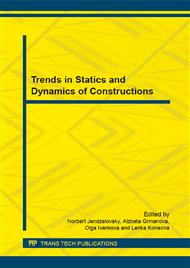p.285
p.289
p.294
p.302
p.308
p.312
p.316
p.320
p.326
Effect of Fibre Type in Concrete on Crack Initiation
Abstract:
Concrete is a traditionally used building material and its crack resistance can be improved by the addition of different types of fibres. Wedge splitting tests on specimens fabricated from five types of concrete mixture (six identical specimens from each mixture) were used to quantify the mechanical fracture parameters of these materials – a reference specimen without fibres, two others with steel fibres (Dramix, Tabix), and a final two with synthetic fibres (Enduro, Strux). Vertical load versus crack mouth opening displacement (P–CMOD) diagrams were recorded during the tests. The data points creating these diagrams were filtered first, subsequently processed and then evaluated using the double-K fracture model. Thus, values were obtained for e.g. Young’s modulus and fracture toughness. This paper is focused on quantification of the effect of the fibre type used in concrete on crack initiation, which corresponds to the beginning of stable crack growth in this sort of composite material.
Info:
Periodical:
Pages:
308-311
Citation:
Online since:
June 2015
Price:
Сopyright:
© 2015 Trans Tech Publications Ltd. All Rights Reserved
Share:
Citation:


